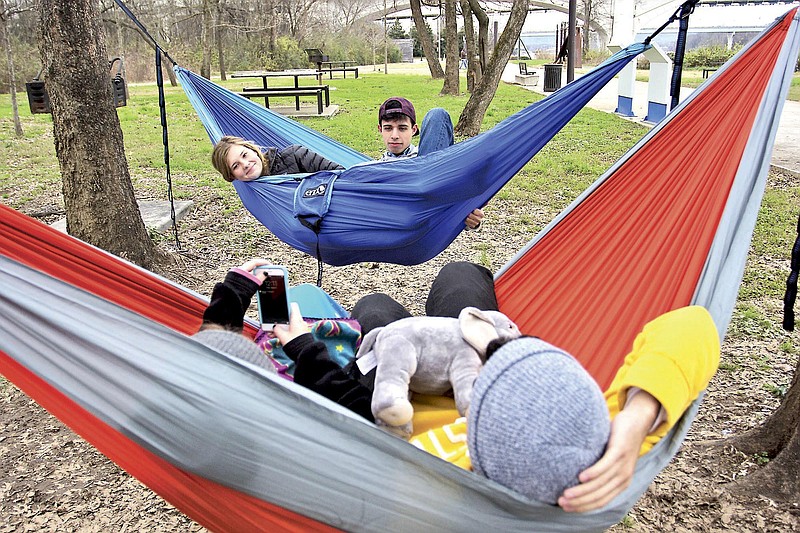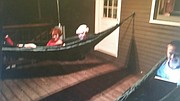Hammock camping tips
› "Drip lines need to be properly attached to the hammock's rain guard," Cabelas camping enthusiast Lindsey Powell explains, referring to the black water-repellent stretch of fabric that covers the hammock user from above. "Otherwise, the water will get into the hammock." › For cold weather, a hammock needs thermal panels, a down blanket and an underblanket. Butt chill is a real danger with hammocks since cold air is flowing underneath. But there are attachments that protect against the wind and with them a hammock can keep you warm even when the temps dip down to 40 degrees › Because they look alike, some campers use those folding windshield heat deflectors as thermal panels. Don't do that. "The thermal panels that capture body heat are designed with tiny air chambers like bubble wrap with each bubble coated in aluminum foil; it's a more complex design than those windshield wraps," Hennessy Hammocks founder Tom Hennessy says. › For summer, campers need to add a hammock mosquito net to their backpacks or buy a hammock already equipped with one such as the Grand Trump Skeeter Beater.
The breathtakingly beautiful Red River Gorge in Kentucky offers hiking among wonders like the 65-foot-tall sandstone Natural Bridge, trails that Daniel Boone blazed and a campsite nicknamed Hammock Land where bright-colored fabric homes swing from the tall trees as far as the eye can see.
Aron Frank's love of fresh air and wilderness is so intense, he lived in Hammock Land more than a year before moving to Chattanooga to work for Rock Creek's outdoor goods store on the North Shore. Like many millennials, he has a wide range of DIY knacks and skills. In the store, he barely needs to look at the pieces as he assembles a hammock that is rainproof, windproof and snug in freezing weather.
"I've never been able to sleep in a hammock overnight," the 25-year-old admits. "I just built a platform bed inside my van."
But Frank adds that he's noticed a steady increase in hammock sales in the past few months and even after the chilly winter weather drifted in.
"Lots of people my age who live in tiny apartments use hammocks as a substitute for furniture like a chair or couch," he says. "My best friend sleeps in a hammock because it takes up less space than a bed. He just rolls it up during the day so he can work, practice yoga, have friends over."
And it's a trend that spreads beyond millennials to adults, teens and even young kids. New technology, polymer fabrics and better design have made today's hammocks very different from the ones Americans have enjoyed for decades. About $200 can buy a sturdy hammock that holds 400 pounds plus a rain guard, wind guard and thermal panels that can keep your warm or keep the heat out.
Asheville, N.C.-based ENO (Eagles Nest Outfitters) is one of the most popular brands among his customers, Frank says. Cabelas sales specialist Lindsey Powell, a 27-year-old cold weather camping enthusiast, says Grand Trunk Hammocks are a customer favorite at her store.
"We've seen an increase in hammock sales here, too, partly because today's hammocks can be used instead of tents; I just sold more than a dozen hammocks to a Boy Scout troop going on a camping trip," Powell says. "The hammocks are much lighter that lugging tent poles and ropes in a backpack up a mountain.
"But I love to hang in my hammock all the time," she says. "My golden retriever hops in alongside me like it's a big comfortable couch."
She adds, though, that the old-school rope hammocks remain popular with customers who are baby boomers and older who "like swinging in them on the front porch."
That's in stark contrast to hammocks made by wild man Tom Hennessy whose Paul Bunyan-ish thrill-packed life is part of the brand that draws customers that include "Naked and Marooned" reality star Ed Stafford, medical teams responding to remote disasters and the U.S. Deep Caving Team.
Hennessy, on the phone while packing up his Canadian island home to fly to his winter home inside a Hawaiian volcano crater on the island of Kauai, says he once rode out a tornado in a hammock.
"Yes, it's true a tornado hit me when I was in a hammock near Lake Michigan on a camping trip in 1968," he says nonchalantly. "The hammock stayed tied to the trees but whirled around. It was a huge hammock, bigger than
a lot of tents. It stayed zipped and I floated around inside like I was weightless for around 20 seconds. Then the twister was gone and the smaller trees on the shore looked like crumpled matchsticks."
He had that crazy ride inside a World War II hammock designed for jungles and made to protect sleeping soldiers from soggy and buggy ground, pooping monkeys, poisonous snakes and biting rats. Those hammocks were almost as big as a tiny cabin with a roof and walls made of mosquito nets. But sleeping in hammocks gave the soldiers aching backs. Hennessy decided he could make the hammock's sturdy design more comfortable. He has patented an asymmetrical design that give firm support to users' backs. He's proud of the tributes from U.S. soldiers on his website, hennessyhammock.com.
"Thanks for the hammock! I spent the last two nights in it getting the best sleep I've had in 6 months," Sgt. Ernest Engman wrote in 2007 next to a video of him with his hammock. "I moved out of my HQ building here in Baghdad and set up a campsite nearby so I can enjoy the better sleep the hammock provides over the cot I had been using."
Along with simply being a place to sleep or hang, today's hammocks can keep users cooler in hot climates because there is airflow under the sleeper. Thanks to space-age materials, hammocks can keep a camper snug and dry as a tent - if the attachments like rain and wind guards are properly assembled.
A basic hammock can cost a camper as little as $99, but each attachment - mosquito net, rain guards, etc.-can cost as much as $100. However, shoppers can save money by getting a hammock already equipped with upgrades.
Chattanooga-based Color Cloud sells vibrantly hued hammocks made by Ethiopian artisans and sold online only. Despite the fabric's ethereal shimmer, the hammocks are strong enough to support 400 pounds.
"Our target is lifestyle hammock users who use hammocks as furniture and relaxation rather than hardcore campers," Color Cloud co-founder Tianna Weaver says.
She works in a building at the corner of Market and East 11th Streets that's owned by Society of Work, the local group that's bringing together entrepreneurs and start-ups needing office space. Society of Work hired Color Cloud to hang a hammock in the lounge for the renters, Weaver says.
"It's very comfortable sitting upright in the hammock while using your laptop," she says.
Chattanooga's John Kristen-Squires' offered coincidental proof of that when she submitted a photo of her kids trying out new hammocks.
"My kids and nephews all got hammocks for Christmas. My brother-in-law hung them on the porch and the kids slept in them while it was warm," she says.
In the photo, one child is snuggled into a hammock with a happy face illuminated by a laptop screen.
Contact Lynda Edwards at ledwards@timesfreepress.com or 423-757-6391.

